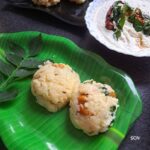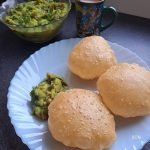Poori and Potato Masala

Poori and Potato Masala are a wonderful combination of the airy, golden-fried goodness of pooris with the savoury masala. Originating from the Indian subcontinent, this unleavened bread has become a cherished part of everyday meals, street food, and grand feasts.
Pooris hold a lot of nostalgic memories. My mom used to make them on Saturdays since they require some time in the morning. I always looked forward to Saturdays to eat pooris.
The perfect Poori requires a handful of simple ingredients – whole wheat flour, water, semolina or sooji, salt, and a touch of oil. Knead the dough to just the right consistency, roll it into small rounds, and then deep-fry in hot oil. The real magic happens in the frying process as the poori transforms and puffs up to create a hollow centre, resulting in a delightful combination of crunch and softness.
Dough consistency for pooris
Start with whole wheat flour (atta), semolina, sugar, oil and a pinch of salt. Gradually add water to the flour while mixing it with your hands. The dough should be firm and smooth, not too soft or too hard. Add water slowly to ensure you don’t make the dough too wet. You want a dough that holds together well but isn’t overly sticky. Knead the dough for a few minutes until it becomes smooth and pliable. This helps develop the gluten in the flour, giving the pooris a good texture. Let the dough rest for at least 15-20 minutes. This allows the gluten to relax and the moisture to distribute evenly, making it easier to roll out the pooris.
You can pair them with various sides such as Potato Masala, chickpea curry, or even sweet accompaniments like halwa. Venturing into the bustling streets of India, you’ll likely encounter the irresistible aroma of street food stalls frying pooris.




Poori and Potato Masala
Ingredients
1 cup = 250ml
Poori
- 2 cups whole wheat flour
- ¾ cup water or as needed for kneading
- 1 tbsp semolina/sooji
- 2 tsp sugar optional
- Salt
- 2 tsp oil
- Oil for frying
Potato Masala
- 5 medium-sized potatoes boiled and mashed
- ½ cup frozen or boiled peas
- 2 tbsps of coconut oil or any cooking oil
- ½ tsp mustard seeds
- A few curry leaves
- 1 tsp urad dal
- 1 tbsp chana dal
- 1 onion finely sliced
- 1 green chilli finely chopped
- 2 tsp finely chopped ginger
- ½ tsp turmeric powder
- Water as needed
- ¼ cup coconut milk optional
- Salt to taste
- Fresh coriander leaves for garnish
Instructions
- In a large mixing bowl, combine the whole wheat flour, salt, semolina and oil.
- Gradually add water and knead the mixture into a smooth, tight dough. The dough should not be too sticky or too dry.
- Cover the dough with a damp cloth and let it rest for about 15-20 minutes.
- Divide the dough into small lemon-sized balls.
- Shape the dough into a small round (approximately 4-5 inches in diameter). Dip them in a small bowl of oil.
- Place the oil-coated ball on your rolling surface. The oil coating helps in rolling out the dough smoothly without sticking and enhances the crispiness of the poori. Flatten it slightly, then roll it out into a circle using a rolling pin. The pooris should be neither too thin nor too thick – about 1/8 to 1/4 inch in thickness.
- As you work on rolling out each ball into a poori, keep the rest of the dough balls covered to prevent them from drying.
- Alternatively, you can also use a tortilla press for pooris. You can lightly oil the surfaces of the tortilla press to prevent the dough from sticking. Close the tortilla press to flatten the dough ball. Apply gentle and even pressure to achieve the desired thickness.
- Heat oil in a deep pan for frying. The oil should be hot but not smoking.
- Slide the rolled dough into the hot oil carefully and press it gently with a slotted spoon. This helps the poori to puff up.
- Fry until the poori puffs up and turns golden brown on both sides. Remove and place on paper towels to absorb excess oil.
Potato Masala
- In a pan, heat oil. Add mustard seeds, urad dal, chana dal, finely chopped ginger, curry leaves and green chillies.
- Add sliced onions and sauté. Cover and cook until they turn soft and translucent.
- Simmer the flame and add turmeric powder. Saute them until the raw smell of the turmeric disappears.
- Add boiled and mashed potatoes, frozen peas and salt. Mix thoroughly.
- Add a few tablespoons of water if it is too dry.
- Cook for 5-7 minutes, stirring occasionally, until the flavours meld together.
- Finally, add the coconut milk and combine well.
- Garnish with fresh coriander leaves and a teaspoon of coconut oil on the top.
- Serve the hot and puffed pooris with the potato masala. Enjoy this classic Indian dish for breakfast, lunch, or dinner!
Notes
- Gradually add water to the flour while kneading. The goal is to create a moist dough, but it should not be overly wet. Remember that the exact amount of water needed may vary based on the type of flour used.
- Allow the dough to rest after kneading. Cover it with a damp cloth and let it rest for at least 15-20 minutes. This resting period helps the gluten to relax, making it easier to roll out the pooris.
- Instead of dusting the balls with dry flour, dip each ball into a small bowl of oil. Ensure that the entire surface of the dough ball is coated with a thin layer of oil.
- The surface of the rolled dough should be smooth, without visible cracks. This ensures that the pooris puffs up evenly when fried.
- You can also press the dough ball between two sheets of parchment paper or plastic in a tortilla press.
- Adding coconut milk to the potato masala is purely optional. It can elevate the flavour of the dish by introducing a rich and creamy texture.
- If you like, you can mix gram flour with water, add after sauteeing the onions, cook it, and then add turmeric, as some restaurants do.
- You can also add frozen or boiled peas along with potatoes to enhance the texture of the potato masala. Peas bring a sweet and slightly crunchy element to the dish, complementing the softness of the potatoes.
